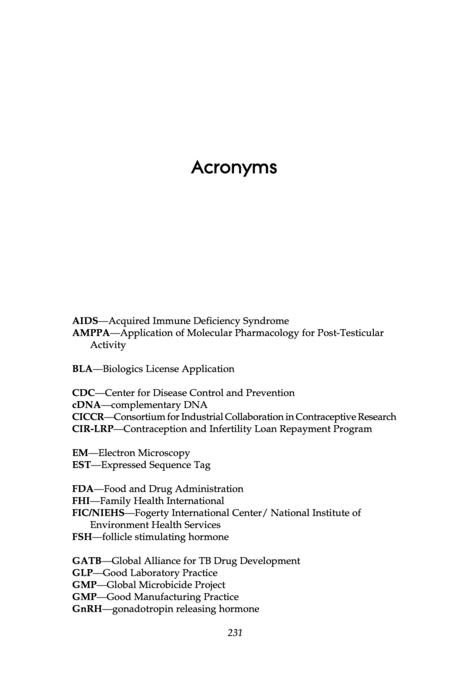Below is the uncorrected machine-read text of this chapter, intended to provide our own search engines and external engines with highly rich, chapter-representative searchable text of each book. Because it is UNCORRECTED material, please consider the following text as a useful but insufficient proxy for the authoritative book pages.
Acronyms AIDS Acquired Immune Deficiency Syndrome AMPPA Application of Molecular Pharmacology for Post-Testicular Activity BLA Biologics License Application CDC Center for Disease Control and Prevention cDNA complementary DNA CICCRConsortium for Industrial Collaboration in Contraceptive Research CIR-LRP Contraception and Infertility Loan Repayment Program EM Electron Microscopy EST Expressed Sequence Tag FDA Food and Drug Administration PHI Family Health International FIC/NIEHS Fogerty International Center/ National Institute of Environment Health Services FSH follicle stimulating hormone GATB Global Alliance for TB Drug Development GLP Good Laboratory Practice GMP Global Microbicide Project GMP Good Manufacturing Practice GnRH gonadotropin releasing hormone 231
232 GPI Glycosyl Phosphatidylinositol hCG human chorionic gonadotropin HIV Human Immuno-deficiency Virus HPTN HIV Prevention Trials Network HTS High Throughput Screening NEW FRONTIERS IN CONTRACEPTIVE RESEARCH ICCR International Committee for Contraception Research IND Investigational New Drug IOM Institute of Medicine IUD Intrauterine Device LCST Lower Critical Solution Temperature LNG-IUS Levonorgestrel-releasing intra-uterine system LH luteinizing hormone NCI National Cancer Institute NDA New Drug Application NICHD National Institute of Child Health and Human Development NIH National Institutes of Health NMR Nuclear Magnetic Resonance OR Olfactory Receptor ORE Open Reading Frame PQS Protein Quaternary Structure RAID Rapid acess to intervention development R.A.N.D rapid access to NCI discovery resources RNAi RNA interference SST Signal Sequence Trap STI Sexually Transmitted Infection UNFPA United Nations Population Fund USAID United States Agency for International Development USDA United States Department of Agriculture WHO World Health Organization


